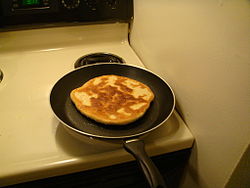 Sugar onion cakes | |
| Type | Savoury or sweet cake |
|---|---|
| Associated cuisine | China, Germany, Korea, Switzerland, Wales |
| Main ingredients | Onion |
| Ingredients generally used | Other cake ingredients |
| Variations | Laobing, pajeon, the scallion pancake, teisen nionod and zwiebelkuchen |
Onion cake is a savory or sweet cake prepared using onion as a primary ingredient. Various onion cakes are consumed in Canada, China, Germany, Korea, Switzerland, Wales and other countries. Several types and varieties of onion cakes exist, including laobing, pajeon, the scallion pancake, Edmonton-style green onion cake, teisen nionod and zwiebelkuchen.




